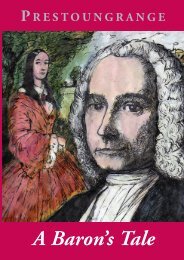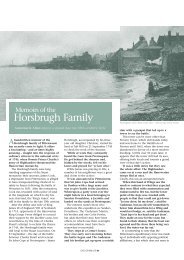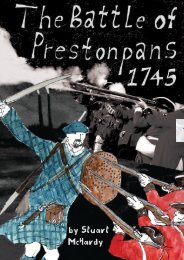Battle of Prestonpans 1745
Battle of Prestonpans 1745
Battle of Prestonpans 1745
Create successful ePaper yourself
Turn your PDF publications into a flip-book with our unique Google optimized e-Paper software.
VICTORY AT PRESTONPANS<br />
the Presbyterian ‘Church <strong>of</strong> Scotland by law established’.<br />
Prince Charles was a stickler for legal form. According to<br />
the usages <strong>of</strong> civilised war at the time he was sedulous in the<br />
care he took <strong>of</strong> the wounded enemy and other prisoners, and<br />
he released their <strong>of</strong>ficers upon their word <strong>of</strong> honour not to<br />
serve against him. In every place <strong>of</strong> any size which came under<br />
his control he had his father proclaimed as King in virtue <strong>of</strong><br />
the authority invested in himself as Prince and Regent.<br />
Furthermore he set up an apparatus <strong>of</strong> civil control, complete<br />
with <strong>of</strong>ficers and tax collectors. What remained to be proved<br />
in the autumn <strong>of</strong> <strong>1745</strong> was whether he could get the better <strong>of</strong><br />
them in open battle.<br />
2. The Spell is Cast: <strong>Prestonpans</strong> 21 September<br />
<strong>1745</strong><br />
On 20 September two armies were moving to contact in the<br />
country to the east <strong>of</strong> Edinburgh. They numbered about 2,400<br />
men each. The Hanoverians were under the command <strong>of</strong><br />
General Sir John Cope. Coming by sea from Aberdeen he had<br />
landed his troops on the 17th and 18th at Dunbar, the nearest<br />
secure port to Edinburgh. On shore he met the two shaken<br />
regiments <strong>of</strong> dragoons which had so far failed even to put up a<br />
token resistance to the Jacobite advance. Cope had shrunk<br />
from doing battle with the Jacobites in the Highlands, but he<br />
was now determined to strike <strong>of</strong>f the head <strong>of</strong> rebellion at a<br />
single stroke.<br />
On the morning <strong>of</strong> the 20th Cope learned that the other<br />
army in question, that <strong>of</strong> Prince Charles, was on the move.<br />
Cope accordingly halted his westward progress on the open<br />
ground which extended from a morass north <strong>of</strong> Tranent<br />
towards the sea. He trusted that the flat and unobstructed<br />
terrain would act to the advantage <strong>of</strong> his troops, and his<br />
dragoons in particular.<br />
Early the same morning Prince Charles and his troops set<br />
out from the east from their bivouacs at Duddinston. A local<br />
girl noted his ‘graceful carriage and comely looks, his long<br />
hair straggling below his neck, and the flap <strong>of</strong> his tartan cloak<br />
thrown back by the wind, so as to make the jewelled St Andrew<br />
dangle for a moment clear in the air by its silken ribbon’.<br />
The Jacobites continued through Fisherrow and crossed the<br />
Esk by the spectacular Roman bridge which gave onto<br />
Mussleburgh.<br />
6










